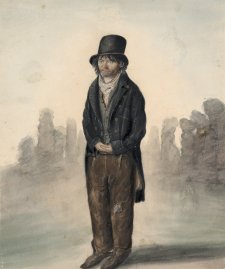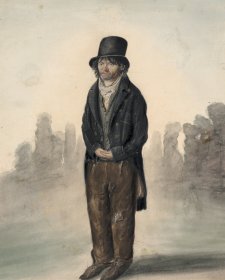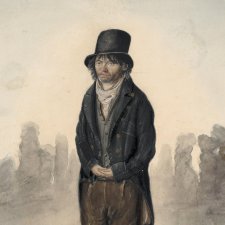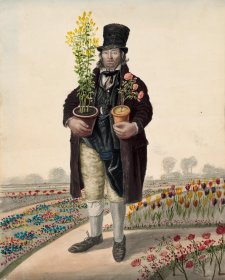‘Dickey’ Fletcher (1748-1827) was a popular character in the resort town of Bridlington, amusing local residents and visitors alike by his ‘singular appearance, rhyming propensity, peculiar manner of pronunciation, drawling and general originality.’ Dickey made many of his announcements in improvised poetry, spoken in a thick Yorkshire accent, or, as one commentator put it, ‘in the unadulterated Doric of his native tongue.’ An example of his doggerel has survived in print, recorded on the morning of 30 July 1825:
‘Tack’n oop this forenoon apod noarth sans
Two keyes, wich I ev i’ my ans; —
Wo-hever as lost ’um mus coom te mea,
An they sal ev ’um agean an we can agrea.’
He was almost as famous for his marriage — at 75 — to the widow of a former bellman, a woman 12 years his senior. An account of the wedding testifies to that condescending combination of affection and mockery common in ‘polite’ attitudes to the poor. The ceremony was very well-attended, and the community provided a carriage, dinner ‘and other et caeteras.’ It was evidently a happy late-autumn affair; Dickey’s obituary reported his pride in ‘walking abroad, at fair times and public occasions, with his ‘better part’, when they generally formed objects of considerable attraction to those to whom they were not particularly known.’
Dempsey’s portrait shows the professional props of hat, handbell and basket (here half-filled with apples), but also captures the casual jauntiness of the man the Hull Advertiser called ‘that eccentric little creature.’ Nevertheless, Dickey’s ricketty legs, walking stick, rheumy eyes and bad teeth remind us of the difficult realities of the sitter’s (low) class and (high) age. In fact, he died on the job. On 22 September 1827, he called with a message at Mr. Gray’s lodging house, tripped, fell down the steps to a basement kitchen and broke his neck.
Collection: Tasmanian Museum and Art Gallery, presented by C. Docker, 1956



30 June 2017
Those of you who are active in social media circles may be aware that through the past week I have unleashed a blitz on Facebook and Instagram in connection with our new winter exhibition Dempsey’s People: A Folio of British Street Portraits, 1824−1844.



Dempsey’s people: a folio of British street portraits 1824–1844 is the first exhibition to showcase the compelling watercolour images of English street people made by the itinerant English painter John Dempsey throughout the first half of the nineteenth century.



Visit us, learn with us, support us or work with us! Here’s a range of information about planning your visit, our history and more!